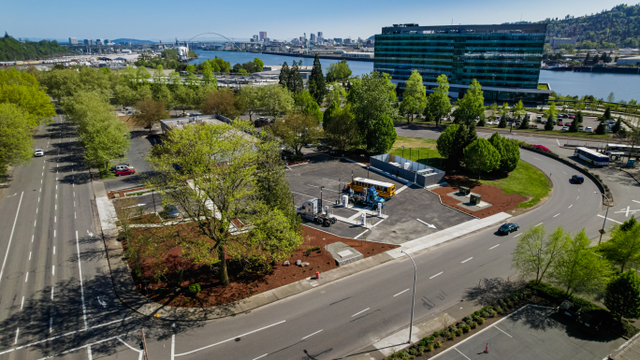True to its nickname “Sand Box,” the first-of-its-kind public charging station designed for medium- and heavy-duty electric commercial vehicles is a site of creativity and collaboration.
In a sector accelerating toward decarbonization for the long haul, Electric Island, located near Daimler Trucks North America’s (DTNA) headquarters in Portland, Oregon, showcases how to power electric vans, trucks and buses today, and will also serve as grounds for innovation and testing.
More than two years in the making, the site debuted in April 2021 with eight high-powered charging stations. The site, formerly a fast-food restaurant, was re-designed to accommodate large electric vehicles.
Electric Island is ready for megawatt-level charging at a rate four times faster than most fast-charging options currently available. The difference means delivery drivers can recharge a vehicle in 20 minutes – time enough to grab a break and a snack – versus hours. In an industry like trucking, where time is money, this is a gamechanger. The collaboration between DTNA and Portland General Electric (PGE) to build Electric Island, with design and engineering expertise from Black & Veatch Provides a virtual sand box of technology. Here, various chargers will be tested for reliability, compatibility, and efficiency with the commercial vehicles.
“The objective is to build up the sandcastles and learn from building them, then knock them down and build them back up better,” said Rustam Kocher, PGE’s utility’s transportation electrification team manager.
Future site plans call for more chargers, on-site energy storage, solar power generation, and a product and technology showcase building.
“This is absolutely the future, and we’re happy to be on the forefront of this,” said Adam Mackey, the DTNA construction design manager who oversaw the project. “I think we’re really hoping to gather from this something that can be replicated over and over.”
“This is one of hundreds of installations that will be like this across the country in the future, and we kind of have the initial recipe,” Paul Stith, Black & Veatch’s director of global transportation initiatives, added. Stith also serves on the boards of the North American Council for Freight Efficiency and Forth, a leading U.S. organization advancing clean transportation.




